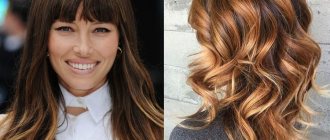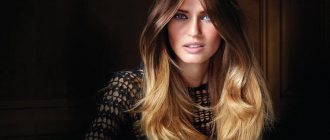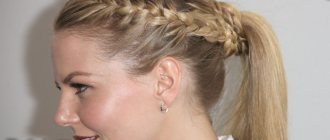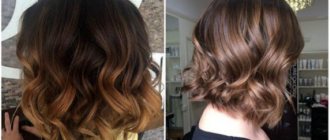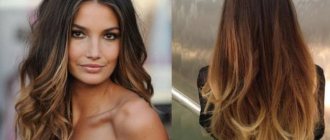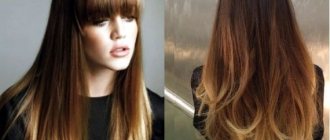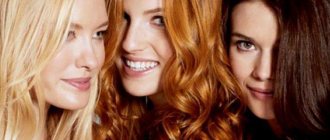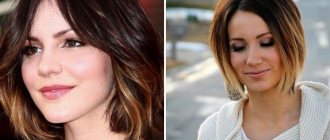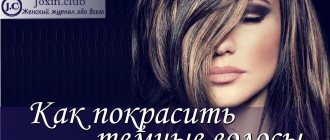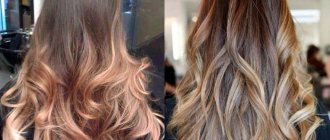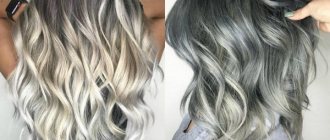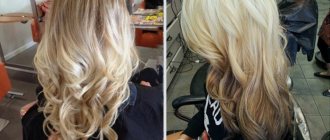Newfangled dyeing techniques include ombre, shatush, balayage, which make the color of the curls beautiful and at the same time natural. How to dye your hair in a stylish and fashionable way? Recently, many unusual and interesting techniques have appeared that allow you to add individuality to your image. Newfangled coloring techniques include ombre, shatush, balayage, which make the color of curls beautiful and at the same time natural. Before you go to the salon for a new hairstyle, it is better to get to know these techniques and find out what their differences are.
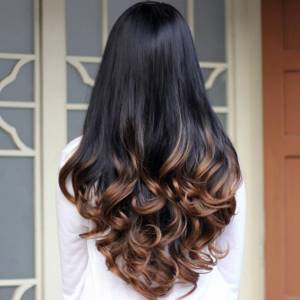
Bright and stylish ombre coloring
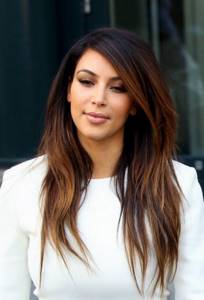
Shatush adds volume to hair
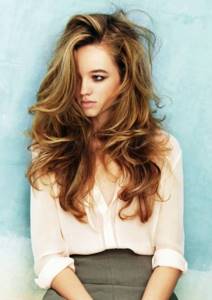
Balayage helps you refresh your usual look
- Types of ombre technology
- What is the shatush technique?
- Subtleties of the shatush technique
- The nuances of balayage coloring
- Is there a difference between ombre, shatush and balayage?
Color density
- How long does the effect last?
- How to choose the right option?
Features of ombre coloring
To understand the difference between shatush and balayage and ombre, you need to learn more about each type of coloring.
Ombre results from creating a smooth transition from one shade to another. In this case, both natural and more extravagant tones are used. With ombre you can add volume to your hair. This coloring looks good on strands of any length.
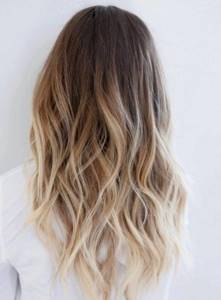
Ombre results from creating a smooth transition from one shade to another. Both natural and more extravagant tones are used
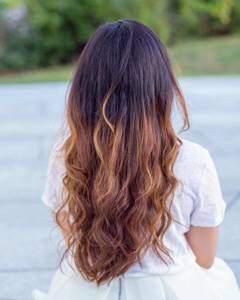
Using ombre you can add volume to your hair
To make the color transition noticeable, ombre is performed on dark strands. The transition is made from the dark root zone to the light tips. At the same time, in the middle between the two shades the border is blurred. The transition to a light tone can begin from the middle of the hair length.
Advice! Balayage or ombre are suitable for hair cut with a ladder. For a short length, you can choose a graduated bob, which will help highlight the curls on the back of the head and face.
This coloring looks good on strands of any length.
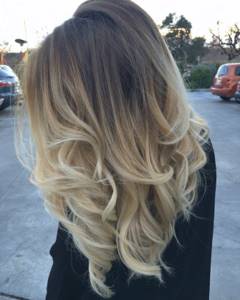
The transition is made from the dark root zone to the light ends. In the middle between the two shades the border is blurred
Types of ombre technology
There are also these types of unusual coloring:
- California ombre is a technique that creates a smooth transition from roots to ends. Usually the shade becomes darker at the roots.
- The shade of the root zone and tips vary greatly. Depending on the color palette, hair can look natural, sun-bleached or bold. This method is also called gradient highlighting.
- Sombre is distinguished by barely noticeable highlights on individual strands. In this case, the roots may be darker than the main length, and the transition border will not be so noticeable.
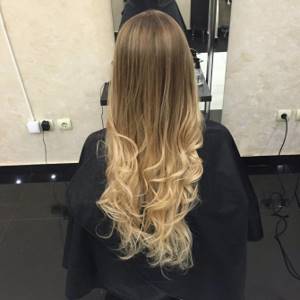
California ombre is a technique that creates a smooth transition from roots to ends. Usually the shade becomes darker at the roots
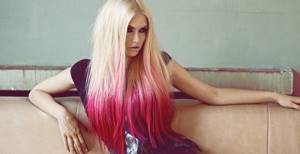
The shade of the root zone and tips vary greatly. Depending on the color palette, hair can look natural, sun-bleached or bold.
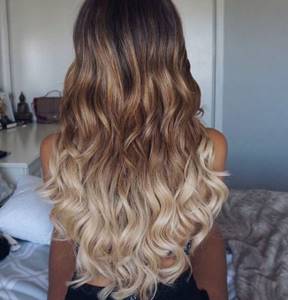
Sombre is distinguished by barely noticeable highlights on individual strands
Advice! Among the brightest techniques, a new type of balayage stands out, which is called dip-dye. It has an original color scheme. The roots are painted a light blonde, and the ends are painted with neon colors.
Balayage: what is it?
Balayage is a bit like shatush, as it allows you to achieve a natural effect. The colored strands are arranged randomly, making them appear slightly sun-bleached. The differences between balayage and shatush lie in the technique of coloring.
Stars spotted with balayage include Jennifer Lawrence, Rosie Huntington-Whiteley, Rihanna, Jessica Alba, Gisele Bundchen, Jessica Biel, Sarah Jessica Parker and others.
Distinctive features
Translated from French, balayage means “revenge.” The colorist applies the dye using sweeping movements (hence the name of the technique). When applying paint, no foil is used - painting occurs in the air or under a special film. Unlike ombre, the border between natural and dyed hair is very soft and practically unnoticeable.
Advantages
- A gentle coloring option: you can use safe coloring pastes.
- The transition between the natural color of the roots and the colored hair mass is invisible and looks natural.
- Suitable for those who want to update their own image, but are not ready to radically change the color of their hair.
- Balayage requires less color correction than shatush and ombre.
- The technique is suitable for previously colored and natural hair.
- Effectively camouflages the first gray hair.
Flaws
- Complex and labor-intensive technology. It is almost impossible to do it yourself at home, so look for a qualified professional.
- Very expensive coloring.
Different types of balayage
Depending on the desired result, the paint can be applied in two ways - in the form of the letters Ш or V. This allows you to achieve soft tints of color.
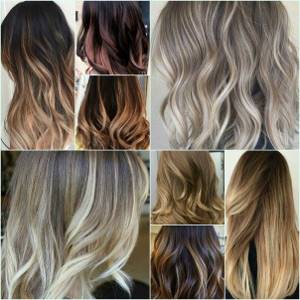
For what length, haircut and hair texture is balayage suitable?
The thickness and structure of the hair can be any. As for the length and haircut, the best option would be haircuts below the shoulder line.
Execution technique
- Separate a narrow strand and pin up the rest of the hair so as not to interfere.
- Apply the paint with light movements using the tip of the brush. The dye is applied in a V-shaped or W-shaped manner.
- Cover the treated strand with film or leave it uncovered.
- Dye all your hair.
- Wait and wash off the dye.
What is the shatush technique?
Shatush is a highlighting technique that gives hair a natural look, as if bleached by the sun. This procedure is also called French highlighting. The technology involves the use of two similar shades. Can be used throughout the hair or to a specific part. Shatush makes the hair more voluminous and even improves the hair structure.
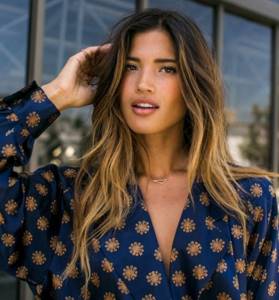
Shatush is a highlighting technique that gives the hair a natural look, as if bleached by the sun.
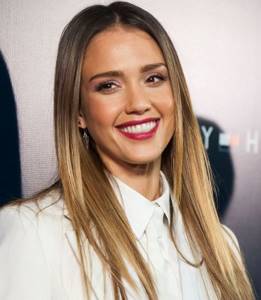
The technology involves the use of two similar shades
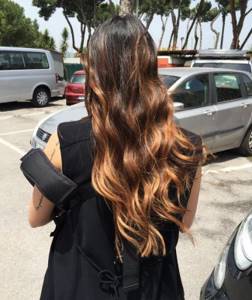
Can be used throughout the hair or to a specific part
This option is suitable for both blondes and brunettes. But on light curls the effect will be weaker. As a result of this coloring, a beautiful and even color transition is created. No additional tinting is required after the procedure.
This technique has the following features:
- Ability to disguise gray strands.
- Gentle and natural dyes are used.
- No foil or special cap is used.
- The procedure is performed in the fresh air.
- Curls can be of different lengths and widths.
- The color stretches along the entire length.
- Used on medium and long hair.
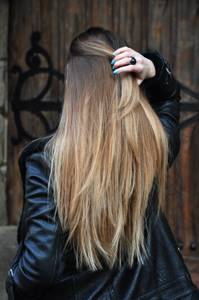
Shatush makes the hair more voluminous and even improves the structure of the hair. This option is suitable for both blondes and brunettes. But on light curls the effect will be weaker
Advice! If the strands are porous and thin, then it is better to choose the balayage method. It will help correct lack of volume, fragility and lack of shine.
Other Features
- Absolute contraindications to the procedures include pregnancy and breastfeeding, taking hormonal medications.
- You should not dye your hair if it is unhealthy, damaged, weak or falling out.
- A graduated haircut will emphasize the special expressiveness of any technique.
- When choosing shades to lighten strands or just the ends, be guided by your own color type of appearance. For girls with a warm type, golden, beige, wheat shades are suitable, for girls with a cold type - platinum, ash, pearl.
- Use shatush to disguise gray hair (if it covers no more than a third of the total mass of hair) or unsuccessful experiments with dyeing, bronzing to revitalize dull curls, balayage for slight changes in appearance. Ombre is a universal option.
Whatever complex dyeing method you choose, do not forget: your hair needs special care. Wash your hair with sulfate-free shampoos, choosing products labeled “for colored curls.” Use masks, balms, conditioners. Lubricate the ends with special anti-split preparations, as well as natural oils. Blow-dry your hair less often, and try not to use hot styling tools. Then your hair will radiate not only shine, but also health.
Highlighting looks great and sophisticated on hair:
- diagonal highlighting;
- with the effect of sun-bleached hair;
- thin, small, frequent;
- basal;
- reverse;
- Californian;
- Venetian;
- glare.
Subtleties of the shatush technique
The procedure time is usually about 40 minutes, which is less than other coloring techniques. The technology consists of painting small strands of hair arranged in a chaotic manner. In this case, small indentations are made from the roots.
The advantage of this coloring is that it can be repeated every three months. This procedure allows you to save on coloring, which is advantageous compared to monthly painting in one tone or with traditional highlighting.
The technology consists of dyeing small strands arranged in a chaotic manner. The advantage of this dyeing is that it can be repeated once every three months
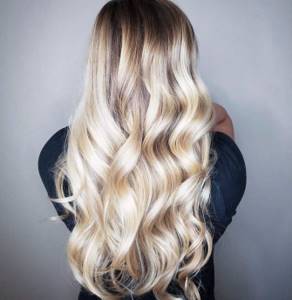
This procedure allows you to save on coloring, which is advantageous compared to monthly painting in one tone or with traditional highlighting
There are two techniques for such application - with and without backcombing. The first option is carried out like this: the strands are divided into thinner ones. Then a coloring composition is applied to individual curls and they are combed. In this case, you can create a beautiful color transition.
This type of technology can damage hair, so modern lighteners and other materials have been created to achieve a similar effect, but in a gentle way.
Advice! The number of shades used may vary, but most often about 4 colors are used. After dyeing, the effect of sun glare appears on the hair.
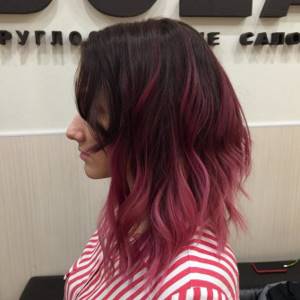
Shatush perfectly masks gray strands Gentle and natural dyes are used
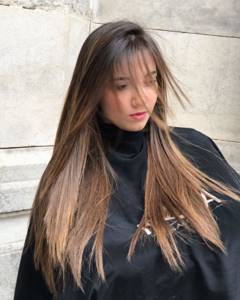
The procedure is performed outdoors
What is shatush
Shatush is a coloring method in which the colorist uses 2-3 shades that are close in tone, as close as possible to the natural hair color. By gently stretching the dye along the strands, the effect of sun-bleached hair with light highlights is achieved.
A distinctive feature is that coloring occurs after combing the hair and without the use of foil. The strands are processed randomly with the dye: this makes it easier to achieve a natural effect.
Which celebrities choose shatush?
Among the stars who prefer this type of coloring are Elizabeth Hurley, Jennifer Aniston, Elizabeth Swank, Jennifer Lopez, Cameron Diaz.
Advantages of technology
- Adds volume.
- Shatush, unlike ombre and balayage, looks more natural.
- Eliminates the unfortunate consequences of highlighting.
- There is no need to frequently touch up regrown roots.
- Due to the rare correction, coloring costs are low.
- This is a relatively gentle dyeing method.
What disadvantages are worth remembering?
- Shatush on light hair does not look as noticeable as on dark hair. If you have light hair, you will have to darken the root zone.
- It is difficult to find a master who does coloring really well.
- The technique is not suitable if you want to create a strong contrast between painted and unpainted areas.
Kinds
- With fleece. Before applying the paint, the strands are combed to achieve a natural transition of tones.
- No backcombing. If combing is not used, you need a special comb-brush, which the master will use to stretch the paint. The “pointless” technique is more subtle and complex, so you will have to find an experienced colorist.
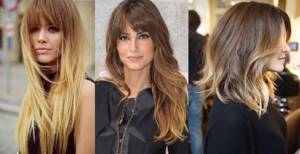
For what length, haircut and hair texture is shatush suitable?
Coloring is performed on long and medium hair. Both straight and layered hairstyles will work. Short haircuts such as garcon, pixie and pageboy do not go well with this type of coloring.
To make the transition between tones natural, it is better to do shatush on wavy and curly hair (or slightly curl straight hair after dyeing). In this case, the hairstyle seems more voluminous and textured.
Execution technique
- Separate a strand about 2 cm wide and pin the rest of the hair with a hairdresser's clip.
- Comb the strand with a thin comb.
- Treat the entire head.
- Apply the prepared paint using a brush to the top layer of combed hair in a chaotic manner.
- Wait for the time specified by the paint manufacturer and wash it off.
- Dry and style.
The nuances of balayage coloring
To better understand the difference between the balayage technique and shatush and ombre, you need to learn more about this method of painting. This method allows you to get the effect of burnt strands, but when applying the dye in a horizontal direction.
The bulk of the coloring composition is distributed only at the tips. This helps to achieve a smooth stretch from a dark natural color to a lighter shade.
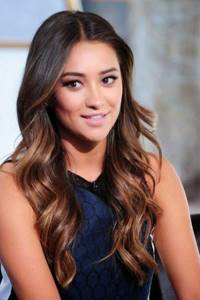
Balayage allows you to get the effect of burnt strands, but when applying the dye in a horizontal direction
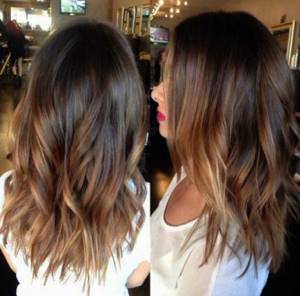
The bulk of the coloring composition is distributed only at the tips
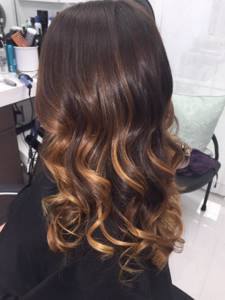
This helps to achieve a smooth stretch from a dark natural color to a lighter shade
Balayage involves alternating different shades. In this case, the color palette is selected taking into account the shape of the face, type of appearance and length of curls.
When using this technique, it is worth considering certain features:
- Balayage is ideal for clear and even haircuts. It is important to carefully process the ends and middle of the hairstyle to create an edge without very noticeable transitions.
- If your hair is short, only the ends are dyed.
- When painting, the brush does not move vertically, but horizontally. For ease of application, the strands are laid out on a flat surface.
- The advantages include the creation of shine and visual volume using this technique. Can be used for thin strands.
Balayage involves alternating different shades. In this case, the color palette is selected taking into account the shape of the face, type of appearance and length of curls
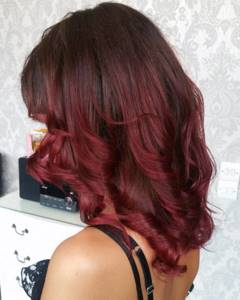
Balayage is ideal for clear and even haircuts. It is important to carefully process the ends and middle of the hairstyle to create an edging without very noticeable transitions
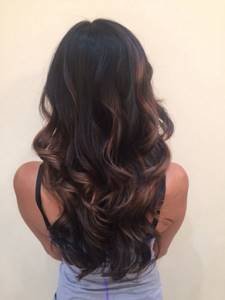
When painting, the brush does not move vertically, but horizontally. For ease of application, the strands are laid out on a flat surface.
Advice! Using this technique you can disguise some facial imperfections. For example, strong roundness of the cheeks, massive cheekbones or a powerful chin.
What is the difference between the procedures?
All of the above techniques allow you to achieve the effect of naturally burnt hair and eliminate the need to constantly touch up your roots. So what are the fundamental differences between them?
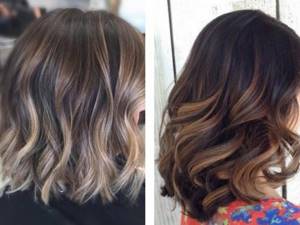
Shatush and ombre techniques:
- the use of shutush technology allows you to achieve a more natural (natural) appearance than with ombre technology. While ombre involves, among other things, creating bright images using non-standard colors and shades, focusing on the transition border;
- Shatush - more economical than ombre due to the ability to make corrections less often;
- Ombre is easier to correct than shatush - the wrong color at the ends can simply be cut off.
Read it, it’s very interesting and useful to find out what nuances of ombre on a bob need to be taken into account in the article: –
Shatush and balayage techniques:
- if shatush looks more natural than ombre, then balayage is the absolute leader among them in terms of creating the most natural effect;
- balayage is also the most economical option, since with it you can make corrections even less often than with the shatush technology, or not do it at all for a long period;
- The shatush technique allows you to camouflage the first gray hair, but balayage disguises it even better due to the chaotic application of strokes.
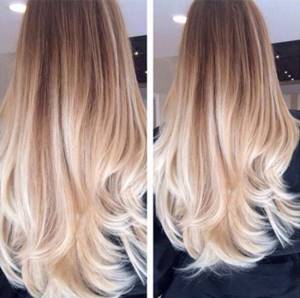
Ombre and balayage techniques:
- Ombre is not suitable for short haircuts, while the balayage technique will help emphasize the ends even with short hair lengths;
- Balayage is more conducive to creating shine and volume in hair compared to ombre.
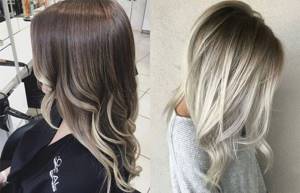
In order to finally determine how one technique differs from another, despite the similarity of the possible result, we present the most significant differences in the table (both in the method of execution and in a number of other characteristics):
| Ombre | Shatush | Balayage | |
| Natural appearance | No | Yes | Yes |
| Location of light strands | from the middle and below | along the entire length of the hair (with a slight indentation from the roots) | along the entire length of the hair (with a slight indentation from the roots) |
| Color transition | quite sharp, with a visible border | blurred | blurred |
| Method of applying the coloring composition | uniform | chaotic | chaotic |
| Direction of application of the coloring composition | vertically | vertically | horizontally |
| Hair length | the longer the better (minimum – square) | any except ultra-short haircuts | any, only the ends of short hair can be dyed |
| Need for correction | once every 2 months | once every 2-4 months | once every 3-6 months |
| Efficiency rating | 3rd place | 2nd place | 1 place |
| Disguise gray hair | minimum | average | maximum |
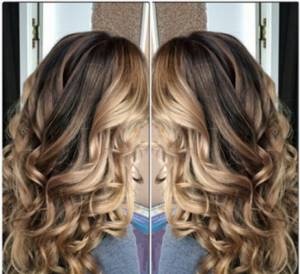
All of the above techniques are now at the peak of popularity and allow you to get rid of the need to constantly tint the ends of your hair, as with monochromatic dyeing. Choose the equipment that’s right for you and please yourself and those around you with a spectacular and attractive appearance!
Author Evgenia Lizarenko especially for the website Style40plus.ru
It’s interesting to know, read: – how to choose the right shade of green and achieve the desired tone.
Is there a difference between ombre, shatush and balayage?
New highlighting techniques have been trending for several seasons now. It is not possible to make them yourself. To perform them, you need certain knowledge, which is taught to professional colorists and hairdressers. To choose the appropriate coloring option, you need to understand the difference between techniques such as balayage, shatush, and ombre. It is necessary to compare according to several parameters.
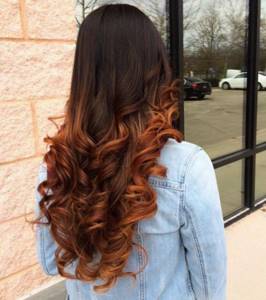
New highlighting techniques have been trending for several seasons now. However, it is not possible to do them yourself. To perform them, you need certain knowledge, which is taught to professional colorists and hairdressers
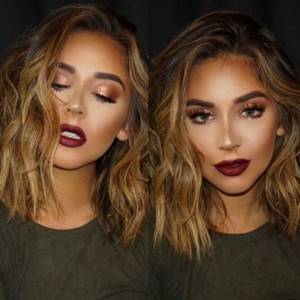
To choose the appropriate coloring option, you need to understand the difference between techniques such as balayage, shatush, ombre
Advice! It is preferable to do ombre on light brown strands so that the main shade is not very light or dark.
Color density
It is most reminiscent of the highlighting technique - shatush. The procedure is performed without foil and in the fresh air. The master determines the width of the strands taking into account the client’s wishes. This type of coloring is gentle. The dyed strands are mixed with natural hair, which creates a magnificent effect, especially on long strands.
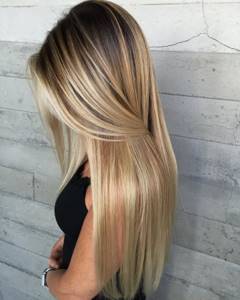
It is most reminiscent of the highlighting technique - shatush. The procedure is performed without foil and in the fresh air.
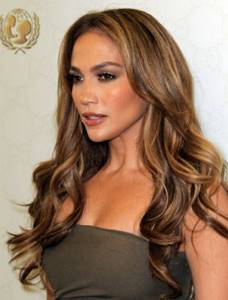
Dyed strands are mixed with natural hair, which creates a magnificent effect, especially on long strands
Balayage is a technique for coloring the ends. In this case, paint is used around the entire perimeter. Shades close to the natural color palette are used. Girls with split ends of their hair should not use this option. Such coloring will only worsen their appearance.
Balayage is a technique for coloring the ends. In this case, paint is used around the entire perimeter. Shades close to the natural color palette are used
Ombre has the same density as balayage. In this case, the ends are also painted, but the color may be more radical. It will be perfect, by the way, with a light bottom and a dark top.
Ombre has the same density as balayage
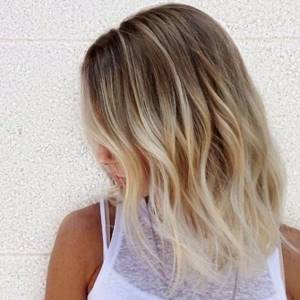
In this case, the ends are also painted, but the color may already be more radical.
Advice! It takes longer to dye light curls, since they are pre-tinted in dark colors.
How long does the effect last?
The duration of the effect is important for women who are very busy and cannot often visit a beauty salon. In this case, ombre or balayage would be more suitable. Shatush requires more frequent adjustments, once a month. It depends on the shade chosen and the speed of hair growth.
Advice! For light transitions, experts recommend choosing copper, amber or honey colors. They fit perfectly on dark strands: red, red or purple.
The duration of the effect is important for women who are very busy and cannot often visit a beauty salon. In this case, ombre or balayage would be more suitable.
Who is coloring suitable for?
Shatush will look natural on the hair of brunettes or fair-haired girls. You should not do it on too short strands, as the effect may be unnoticeable. This is a great way to cover gray hair.
Shatush will look natural on the hair of brunettes or fair-haired girls
Balayage is recommended for girls who want to refresh their look, but not use radical dyeing methods. Looks good on blondes and lighter strands. On dark hair the effect will be noticeable.
Balayage is recommended for girls who want to refresh their look, but not use radical dyeing methods.
Ombre is suitable for girls with short hair. It is often chosen by teenagers who prefer extreme style. For this option, bright shades are used. For example, crimson, purple or yellow. It is worth making sure that your clothing style matches your chosen hairstyle. You can see what ombre, shatush or balayage looks like on hair in the photo.
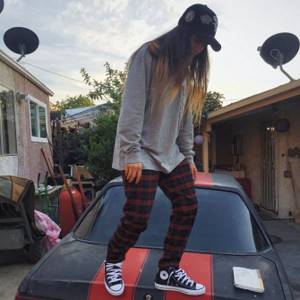
Ombre is often chosen by teenagers who prefer extreme style.
Advice! When choosing a color, you should consider that the shade matches your skin color. Strands with shades of blonde will look great with tanned skin. Light skin goes well with a copper-red palette. And light brown tones harmonize with darker skin tones.
Differences and similarities between ombre and shatush
Ombre is a hair coloring technique that creates the effect of a smooth transition of colors and shades . At the top of the head the hair is darker, and as it approaches the ends it becomes lighter. Coloring in the amber style can have either a smooth transition of hair shades or a sharp one. This technique is a type of hair coloring.
Shatush is characterized by the effect of sun-bleached hair, namely the ends. Coloring using the shatush technique is relevant for dark-haired women.
The difference between shataush and ombre is that the shatush technique requires light ends of the hair.
Shatush can be safely classified as a type of highlighting. This is a gentle hair coloring, since only part of the hair is treated red. Also, the paints used in this technique can be classified as less thermonuclear.
Distinctive features of the Shatush style:
- This type of highlighting boldly combines strands of different widths and thicknesses.
- The master dyes frequent and sparse strands, which is why the effect of negligence is achieved. Strands can be proportional or chaotic. This is a trick that allows you not to subject your hair to additional coloring for a long time.
- No foil is used during the painting process. During painting, the dyed curls are in free contact with the untouched ones.
Shatush is used in combination with other coloring techniques, but is not relevant for women with short haircuts.
Experts see the difference in the directions of coloring shatush and ombre based on the composition of the paint. The composition of shatush uses clarifiers to a much lesser extent.
Shatush is relevant for girls and women of different age groups and types. The specialist selects paints individually, playing on contrast or similarity.
Read also: Highlighting on black hair: before and after photos
How to make shatush in a hairdresser
- Thin strands stand out.
- Comb each curl to achieve a gradient transition.
- Color the strands with short strokes.
- Toning is performed to protect hair from harm from dyes.
Shatush hair coloring technique
The method of applying coloring is also similar and causes confusion even among experienced hairdressers.
The similarities in these two styles are the special effect of carelessness, the contrast between the roots and ends of the hair, and the transition of colors and shades.
A huge advantage of shatush, like ombre, is the absence of the need for constant correction.
When faced with a choice between two coloring styles, you need to start from the final goal.
Ombre will give its owner mystery and unusualness. This elegant style looks great on dark hair, adding sophistication to the wearer.
Shatush creates the image of a carefree fashionista whose favorite pastime is vacationing on the islands. The hairstyle evokes thoughts of carelessness and vacations in distant warm countries. Shatush, however, is a little more popular, since, according to fashionistas, it looks more interesting than ombre.
Just a few years ago, growing out the roots of dyed hair was the height of bad taste and careless attitude towards one’s appearance. But today experiments with colors and shades are in trend.
.
Darkening, light or multi-colored transitions, smooth, sharp changes in colors, stretching shades - all this is fashionable and relevant in the new season.
Features of ombre
- Unlike shatush, the transition of colors and shades of ombre occurs in the total mass of the hair.
- Coloring involves the use of paints of various shades, bold ideas and bright solutions.
- Coloring involves using at least 3 colors.
- Stylists distinguish two types of amber - with a smooth and sharp transition. A sharp transition is less expensive, but also less popular.
- The style has many interpretations: color painting, multi-tone, zonal, reverse, Scandinavian, monochrome.
The amber technique gained popularity thanks to the light hand of Hollywood star Sarah Jessica Parker.
Ombre coloring technique
- Lightening strands.
- Hair tinting
- The strands are dyed for 20 minutes, after which the paint is washed off and the ombre is ready.
Read also: Types of highlighting
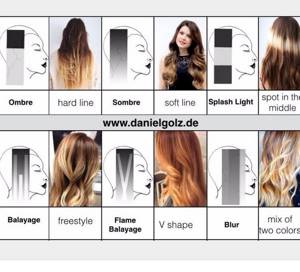
The use of these two competing styles gave rise to a middle style called balayage .
- This technique combines the properties of these two styles.
- It includes lightening the ends, in the total mass of the hair, while colors are used that are close to the natural color, without sudden changes.
- Balayage does not have long transitions.
- The shade used is close to the natural hair color, the paint is stretched with a brush.
- The artist does not use foil and dyes the strands in the air.
- When choosing between ombre or balayage techniques, you need to proceed from your personal wishes and hair structure. Wavy and curly hair will be brightened up with the ombre technique.
Shatush, ombre, balayage are complex coloring techniques. The main difficulty and task of the master is the effect of naturalness, softness and naturalness. By choosing one of the ombre, shatush or balayage coloring techniques, a fashionista will definitely not be a loser.
How complicated is the procedure?
It will not be possible to make shatush at home. Only a specialist will be able to choose the correct width of strands and shade that will look natural.
You can do balayage and ombre yourself if you don’t plan to stretch the color along the entire length of your hair. All types of coloring take up to three hours.
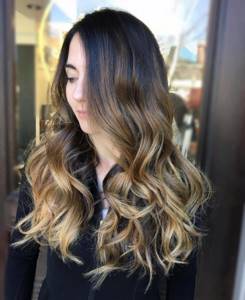
It will not be possible to make shatush at home. Only a specialist will be able to choose the correct width of the strands and the shade that will look natural. You can do balayage and ombre yourself if you do not plan to stretch the color along the entire length of the hair.
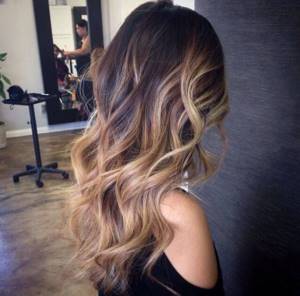
All types of coloring take up to three hours
Advice! You can visually raise your forehead with the help of light strands on your bangs, and lightened curls along the face will help to slightly narrow a wide face.
